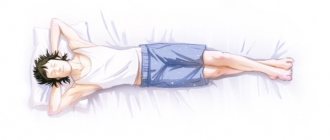Isotherapy
is one of the most common and widely used types of art therapy. Treatment and solution of various problems with the help of fine art is very popular and accessible to many. A person (client) can express himself, his thoughts, experiences, emotions and feelings - everything that is hidden in his inner world - with the help of lines, shapes and colors on paper or canvas.
Isotherapy is an effective and efficient method that helps a person cope with negative emotions and relieve neuropsychic tension. A wide range of materials is used for drawing: different paints (gouache, watercolor, acrylic, etc.), pencils, charcoal, pastels, wax crayons - everything that leaves a mark on paper and can create a drawing or imprint. Despite its effectiveness, isotherapy as a separate method of treatment and psychological assistance appeared about half a century ago.
How and who will benefit from isotherapy?
The demand for isotherapy is explained by the fact that the process of drawing as such gives a person the opportunity to unload, relieve stress, calm down and feel satisfaction from the activity. For preschool children, drawing is a common way of expressing themselves, reflecting and comprehending their new experiences. When working with a child, isotherapy provides a lot of information about the child and his inner world: what he thinks, what he feels, what he is afraid of, who and what he loves, etc. Children literally “speak” to others through their drawings. A competent psychologist and an attentive adult will be able to understand the child much faster and easier and help him using the knowledge of isotherapy.
With the help of isotherapy, adults and children can cope with problems such as:
- express your emotions and feelings in a way that is safe for yourself and others. Isotherapy is effective in cases where you need to free yourself from psychological constriction, aggressiveness, nervousness, imbalance, jealousy, fears, etc.
- low self-esteem. According to statistics, more than 70% of people suffer from low self-esteem and self-doubt. Thanks to practical isotherapy exercises, anyone can significantly increase their self-esteem and become more confident.
- behavior problems.
- relationship problems and/or family problems.
- chronic stress and psychosomatic diseases.
In addition, isotherapy classes help to unlock creative potential and open up new resources and opportunities in a person.
How are isotherapy classes conducted?
Isotherapy classes are conducted both in individual consultations and in group trainings and seminars. Depending on the client’s request (or the topic of the training), the psychologist gives special exercises and tasks from the field of isotherapy. When all the tasks are completed, they move on to the second important stage - analysis and comprehension of the material and information that they managed to bring to the light of consciousness. At this stage, clients often have their own personal insights (insights) - moments of clarity and understanding of their problem. The client, with the help of a psychologist, begins to see and understand ways to solve his problems, and sometimes the problem is solved right in class during the process of creating drawings.
After isotherapy sessions, clients can save their drawings or do with them what their intuition tells them.
Even one training or consultation on isotherapy can give a new positive experience and reveal to a person something that he had no idea or did not know about. And an integrated approach (a series of trainings or consultations) can take you to a new level and solve many, even long-standing problems. Color therapy is a field of science and practice about the effects of color on the physiological and psychological state of a person.
Since time immemorial, humanity has known the incredible power of color.
And with the advent of experimental science, scientists were able to prove that colors have a physiological effect on humans
, and this is an objective fact. A person’s very attitude towards flowers is subjective and may depend on his mood, psycho-emotional state and stage of life.
How it works
In psychology, there is the concept of “overcontrol” - this is the part of the mind that censors all forms of thought. It is because of this that we do not say out loud everything we think about. But he is completely powerless in front of images, in particular those that are created in the process of drawing. Therefore, by carefully studying what a person has depicted, psychologists are able to understand what is actually happening to him and how he can be helped. Sometimes the simple act of pouring out what has accumulated inside is enough, and it becomes easier without the involvement of additional therapeutic techniques.
What is color therapy based on?
Color therapy is based on the fact that nature and the human body have 7 colors that are in balance with each other. If this balance begins to become distorted and destroyed, then our body can get sick. What does illness mean from the point of view of art therapy and color therapy? First of all, this is the emergence of disharmony, a violation of order in the body. The disease can combine a number of symptoms, which, with a protracted process, move to the chronic stage - the stage of the disease. In turn, the orderliness and harmony of a person’s internal state represents health.
Basic principles
Isotherapy classes are organized taking into account the basic principles on which this area is based.
- You cannot set the task to draw beautifully or correctly. The more arbitrary the image, the more accurately it will convey what is happening inside a person.
- Do not provide opportunities for self-evaluation and criticism (“I can’t draw,” “I’m not much of an artist”).
- Provide a wide range of visual instruments. Their choice can tell a lot: a pencil will be taken by a pedant or a perfectionist, paints by a freedom-loving nature, felt-tip pens by a person prone to insincerity and lies.
- No rulers, compasses or other drawing supplies. Everything is done entirely by hand.
- Create an appropriate environment so that there are no distractions.
- A psychologist (psychotherapist) should not interfere in the drawing process: you cannot comment, clarify, or explain anything.
- It is imperative that the painter, upon completion of the work, comment on what he captured. Sometimes even a specialist can misinterpret what is depicted.
- In group classes, other participants should not be allowed to comment on others' drawings without their consent.
- To track changes occurring in a person, a specialist collects drawings into a separate portfolio, based on which he regularly draws conclusions and adjusts the course of correction or treatment.
If one or more principles are violated, isotherapy classes may turn out to be completely useless and ineffective.
How does color therapy affect health?
In order for a person to be in a state of health, his soul, mind and body must be in harmony and interact in concert. If a person’s health deteriorates and diseases appear, then first of all it is necessary to awaken and activate the body’s hidden reserves, give the person access to them and teach him to feel and trust himself. An art therapist, using special art and color therapy techniques, awakens hidden resources in the client’s body that can restore health and cure diseases. Color therapy, having a direct impact on our feelings and inner world
, provides amazing opportunities for activating hidden abilities, talents and human potential.
From the history
The first references to isotherapy date back to the end of the 19th century, when such a term did not even exist. The notes of a doctor in a French mental health clinic describe how his patients loved to draw during the exacerbation of their illnesses and gave up this activity as soon as they recovered. These ideas were picked up by the psychiatrist M. Simon and the forensic physician A. Ardier, who began to use drawings to clarify the diagnoses of mentally ill people. Many consider them to be the real founders of this trend in psychotherapy.
The term itself was first used by Adrian Keith Graham Hill, an English artist, teacher, art therapist, and quite a popular TV presenter. After graduating from the School of Art and going through the First World War, in 1938 he ended up in a tuberculosis dispensary. It was there, observing the sick, that he concluded that the disease was looking for a way out through drawings. After World War II, he began to actively introduce art therapy into psychology and psychotherapy. Visual arts were successfully used in working with children who went through the horrors of Nazi concentration camps.
The technique has become incredibly popular and has developed into a separate, independent direction. The idea was picked up by such famous psychologists as K. Rogers, R. May, A. Maslow. They all agreed that every person involuntarily holds back abilities that need to be released for successful self-realization, and they considered isotherapy to be one of the most effective ways for this.
Color therapy and art therapy
In the field of art therapy and psychology, color therapy is most often used through drawing with certain colors and meditation on color accompanied by relaxing musical accompaniment. Any person intuitively practices color therapy, without even realizing this fact.
By choosing certain colors in clothes, accessories, food, etc., a person gets the energy that he currently lacks from the colors he chooses. However, we all have our preferences for certain colors and ignoring or excluding others. For what reasons one person likes this or that color is not given to us to understand, but we know for sure that the choice of colors occurs unconsciously, intuitively, and therefore is the most truthful and trustworthy when diagnosing and correcting the condition.
Because color is the most important factor that largely determines the state of a person’s psychological and physiological health. In each color we can find a whole sea of shades and tones, immersing ourselves in which we are filled with their energy, strength and deep content. And only with such a full sensation of color, when we absorb and taste it, when we enjoy its perception, we can understand what this color means to us and feel its influence on us as much as possible.
Color therapy is the most natural and gentle way to restore strength, energy and health. This is a pleasant and exciting method that can quickly increase a person’s mood, energy level and vigor. Once you have tried color therapy in action and felt the effectiveness of its effects, you will want to experience its resources and capabilities again and again.
What it is
In the narrow sense of the word, isotherapy is a direction of art therapy that uses fine art methods to normalize the mental state of children and adults. In a broad sense, this is art therapy itself, since initially it was meant as work with drawings of people who need the help of psychologists and psychotherapists. It was later that it acquired new trends (dance, sand, drama, music and other therapies), so it was necessary to allocate a separate niche for painting.
Initially, isotherapy was used in psychiatry to diagnose diseases of the mentally ill (late 19th century). Then, having formed a separate direction, she migrated to psychotherapy as part of the treatment course for certain mental disorders. Today it is used in many areas. For example, in psychology this is one of the methods of both testing and correction. She is actively involved in social work not only with children suffering from deviant behavior, but also with various problem segments of the population, including the elderly, disabled, and people without a fixed place of residence.
Isotherapy exercises
Exercise “Let's pretend to be happy”
The purpose of the exercise is to improve the emotional background with the help of color and concentration on your feelings.
Material used: paper. watercolor paints, brushes.
Description of the exercise: To work, you need to sit down, relax, close your eyes and imagine the most joyful moments of your life, feel all the sensations. After this, you should imagine your feelings in the form of flowers and figures. There is no need to stress, only emotions and sensations are important here. It is enough to stay in this state for 10–15 minutes. After this, the images you see can be transferred to paper.
Exercise “Drawing music”
The purpose of the exercise is to restore strength, relaxation, and calmness.
Materials used: Calm melody, sheets of paper, watercolor, brush.
Description of the exercise: At the beginning of the lesson (the first 10 minutes), you need to close your eyes and immerse yourself in the music. Then you can take a brush and paint. In the process of work, the hand should spontaneously follow the music. When performing the exercise, you need to focus on your feelings and the pictures that appear before your eyes. The result is a bright positive mood, a surge of strength, and a release of tension.
Types and forms
Forms
Isotherapy is presented in two forms - active, when a person draws himself, and passive, when he works with ready-made works of art. In the first case, he releases his unconscious, which breaks out from under the yoke of “overcontrol”. In the second, he expresses judgments that help the psychologist (psychotherapist) understand his inner beliefs and worldview, and sometimes his temperament.
For example, Malevich’s “Black Square” for rationalists is just a dark rectangle, for people with stuck accentuation of character - a failed picture, for a hyperthymic temperament - a multi-colored cube, for the affectively exalted - a rebellion in art, etc.
Types of activities
Isotherapy is carried out in the form of individual, pair and group sessions.










